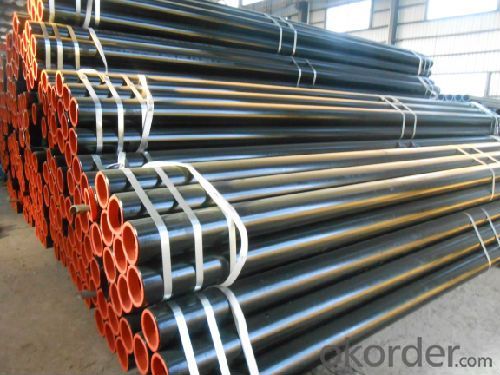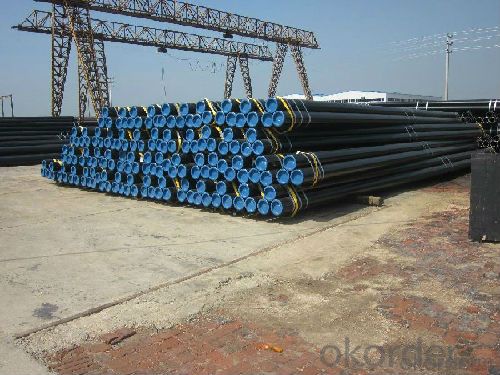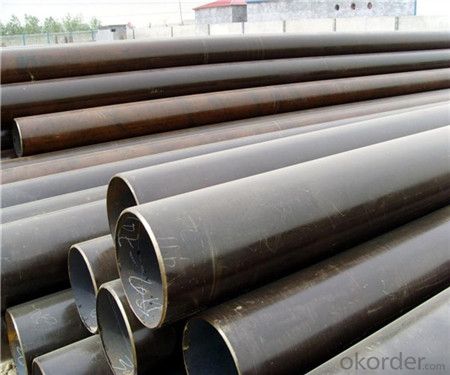Stainles Seamless Steel Pipe 201 /304 /316 /430 used for Oil Pipe Manufacturer
- Loading Port:
- China Main Port
- Payment Terms:
- TT or LC
- Min Order Qty:
- 30 m.t.
- Supply Capability:
- 12000 m.t./month
OKorder Service Pledge
OKorder Financial Service
You Might Also Like
1、Structure of Seamless Pipe ASTM A106/53:
carbon seamless steel pipes are widely used in gas, water and oil, transpotation;constructions;Bridge,highway,windows of model steel door; building materials;fences;heating facilities Fluid Pipe;conduit pipe,scaffolding pipe.etc.
Payment Terms: L/C D/A D/P T/T
Packing and shipment
Packaged in bundles,as per customers' requirements, it can also bepackagesd as beveled ends, typed marking, black painting, plastic caps protection,woven bags packing
For 20" container the max length is 5.8m; For 40" container the max length is 12m. other options are available based on customer requests. Please discuss when placing orders.
2、Main Features of the Seamless Pipe ASTM A106/53:
• High manufacturing accuracy
• High strength
• Small inertia resistance
• Strong heat dissipation ability
• Good visual effect
• Reasonable price
3、Seamless Pipe ASTM A106/53 Specification:
Standard | GB, DIN, ASTM ASTM A106-2006, ASTM A53-2007 |
Grade | 10#-45#, 16Mn 10#, 20#, 45#, 16Mn |
Thickness | 8 - 33 mm |
Section Shape | Round |
Outer Diameter | 133 - 219 mm |
Place of Origin | Shandong, China (Mainland) |
Secondary Or Not | Non-secondary |
Application | Hydraulic Pipe |
Technique | Cold Drawn |
Certification | API |
Surface Treatment | factory state or painted black |
Special Pipe | API Pipe |
Alloy Or Not | Non-alloy |
Length | 5-12M |
Outer Diameter | 21.3-610mm |
Grade | 20#, 45#, Q345, API J55, API K55, API L80, API N80, API P110, A53B |
Standard | ASME, ASTM |
1) Material:20#(ASTM A 106/A53 GRB.API5LGRB,GB),45#,16Mn,10#.
2) Specification range:OD:21.3-610mm,WT:6-70mm,length:6-12m or according to the requirement of clients.
3) Excutive standards:GB,ASME API5L.ASTM A 106/A53,Despite of the above standards,we can also supply seamless steel pipe with standard of DIN,JIS,and so on,and also develop new products according to the requirements of our clients!
4) Surface:black lacquered,varnish coating or galvanized.
5) Ends:Beveled or square cut,plastic capped,painted.
6) Packing:bundles wrapped with strong steel strip,seaworthy packing.
4、Packaging & Delivery
Packaging Details: | seaworthy package,bundles wrapped with strong steel strip |
Delivery Detail: | 15-30days after received 30%TT |
5、FAQ of Seamless Pipe ASTM A106/53:
①How is the quality of your products?
Our products are manufactured strictly according to national and internaional standard, and we take a test
on every pipe before delivered out. If you want see our quality certifications and all kinds of testing report, please just ask us for it.
Guaranteed: If products’ quality don’t accord to discription as we give or the promise before you place order, we promise 100% refund.
②How about price?
Yes, we are factory and be able to give you lowest price below market one, and we have a policy that “ for saving time and absolutely honest business attitude, we quote as lowest as possible for any customer, and discount can be given according to quantity”,if you like bargain and factory price is not low enough as you think, just don’t waste your time.Please trust the quotation we would give you, it is professional one.
③Why should you chose us?
Chose happens because of quality, then price, We can give you both.Additionally, we can also offer professional products inquiry, products knowledge train(for agents), smooth goods delivery, exellent customer solution proposals.Our service formula: good quality+good price+good service=customer’s trust
SGS test is available, customer inspection before shipping is welcome, third party inspection is no problem.
6、Seamless Pipe ASTM A106/53 Images:



- Q:Can stainless steel pipes be used in power plants?
- Yes, stainless steel pipes can be used in power plants. Stainless steel has excellent corrosion resistance, high-temperature strength, and durability, making it suitable for various applications in power plants, including transporting fluids and gases, supporting structural components, and handling high-pressure environments.
- Q:What are the limitations of using stainless steel pipes?
- There are several limitations associated with the use of stainless steel pipes. Firstly, stainless steel pipes tend to be more expensive compared to other materials such as PVC or copper. This can make them less feasible for projects with budget constraints. Secondly, stainless steel pipes can be more difficult to install and require specialized tools and equipment. This can increase the overall installation time and cost. Another limitation is that stainless steel pipes are not suitable for transporting certain corrosive chemicals or gases. They may react with certain substances, leading to corrosion and potential damage to the pipes. In such cases, alternative materials like plastic or lined pipes may be more appropriate. Additionally, stainless steel pipes may have limitations in terms of temperature and pressure resistance. While they can handle relatively high temperatures and pressures, extreme conditions may require the use of more robust materials. Furthermore, stainless steel pipes have a lower thermal conductivity compared to other materials, meaning they are not as efficient at transferring heat. This can be a limitation in certain heating or cooling applications where rapid heat transfer is required. Lastly, stainless steel pipes can be prone to expansion and contraction with temperature changes. This may require the use of expansion joints or other measures to accommodate for these movements and prevent potential damage. Overall, while stainless steel pipes offer numerous benefits such as durability and corrosion resistance, their limitations should be carefully considered before selecting them for a particular project.
- Q:What is the difference between double wall and single wall stainless steel pipes?
- The main difference between double wall and single wall stainless steel pipes lies in their construction and applications. Single wall stainless steel pipes are made up of one layer of stainless steel. They are commonly used in various industrial applications such as plumbing, heating, ventilation, and air conditioning systems. These pipes are known for their durability, corrosion resistance, and high tensile strength. Single wall stainless steel pipes are suitable for transporting fluids and gases at moderate temperatures and pressures. On the other hand, double wall stainless steel pipes consist of an inner and outer layer of stainless steel, with a layer of insulation in between. The insulation layer provides thermal insulation, preventing heat transfer and maintaining the temperature of the fluid or gas inside the pipe. Double wall stainless steel pipes are typically used in applications where temperature control is critical, such as in high-temperature industrial processes or in the transport of hot or cold fluids. Due to their insulation layer, double wall stainless steel pipes have superior energy efficiency compared to single wall pipes. They minimize heat loss or gain, reducing energy consumption and optimizing the efficiency of heating or cooling systems. Additionally, the insulation layer also helps to reduce condensation, which can prevent damage to surrounding equipment or structures. In summary, the main difference between double wall and single wall stainless steel pipes is the presence of an insulation layer in double wall pipes. This insulation layer provides thermal insulation, making them suitable for applications that require temperature control and energy efficiency. Single wall pipes, on the other hand, are commonly used in various industrial applications that do not require insulation or stringent temperature control.
- Q:Why is the outer diameter of 1 inch galvanized pipe 33.7? And the outer diameter of one inch stainless steel pipe is 25.4
- The 1 inch galvanized pipe refers to the nominal size holes of 1 inches of water, the outer diameter is 33.7, its diameter fits a 1 inch pipe thread wire, and one inch stainless steel tube outer diameter is 25.4 that of the tube is in diameter standard specifications.
- Q:What's the difference between stainless steel 302 and 304?
- Plate type heat exchanger, corrugated pipe, household appliances (1, 2 kinds of tableware, kitchen cabinet, indoor pipeline, water heater, boiler, bath), auto parts (windshield wiper, muffler, mold), medical appliances, building materials, chemical, food industry, agriculture, marine parts, millet mobile phone etc.. 304 stainless steel is a nationally recognized food grade stainless steel.
- Q:Mirror stainless steel tube 60*60 how much is one meter?
- Examples are stainless steel 63 round tubes, solid thickness 0.82 stainless steel tubes, single support 6 meters long, weight (63-0.82) *0.82*0.02491*6=7.62kg, a six meter long 63 round tube, thickness 0.82, theoretical weight is 7.62kg;
- Q:What is the difference between 321 and 316 stainless steel pipes?
- The chemical composition and intended applications distinguish 321 stainless steel pipes from 316 stainless steel pipes. 321 stainless steel pipes, containing titanium, ensure stability against chromium carbide formation, resulting in high resistance to intergranular corrosion even at elevated temperatures. Consequently, they find common use in industries like aerospace and power generation, where high temperatures are prevalent. Conversely, 316 stainless steel pipes lack titanium but incorporate molybdenum, which enhances their corrosion resistance, especially in environments with chloride ions, making them suitable for marine and coastal applications. Moreover, 316 stainless steel pipes excel in the food and beverage industry due to their exceptional resistance to acids and chemicals. To summarize, although both 321 and 316 stainless steel pipes exhibit excellent corrosion resistance, the presence of titanium in 321 stainless steel pipes elevates their resistance to intergranular corrosion at high temperatures, while the inclusion of molybdenum in 316 stainless steel pipes enhances their ability to withstand chloride-based corrosion in marine and coastal settings.
- Q:What are the different types of fittings used with stainless steel pipes?
- Stainless steel pipes can be paired with various types of fittings, depending on the specific needs and application. Here are some of the most commonly used fittings: 1. Compression fittings: These fittings create a tight, leak-proof connection by compressing a ferrule onto the pipe. They work well with both rigid and flexible stainless steel pipes and are easy to install. 2. Threaded fittings: Known as screwed fittings, these have female threads that can be screwed onto the male threads of the pipe. They are commonly used in low-pressure situations and can be easily installed or removed. 3. Butt weld fittings: These fittings are used to make a permanent, welded connection between two stainless steel pipes. The pipes need to be beveled to create a V-shaped groove, and they are typically used in high-pressure or high-temperature settings. 4. Flange fittings: Flanges are utilized to connect two stainless steel pipes or connect a pipe to a valve, pump, or other equipment. They provide a strong and leak-proof connection and can be bolted or welded onto the pipe. 5. Push-to-connect fittings: These fittings offer a quick and tool-free connection. They use a push-in mechanism to secure the pipe and are commonly used in plumbing and air compression systems. 6. Camlock fittings: Camlock fittings enable rapid connection and disconnection of hoses and pipes. They have a lever or cam mechanism that locks the fitting into place, ensuring a secure connection. These fittings are often used in industrial settings where frequent connections and disconnections are necessary. Ultimately, the choice of fitting depends on factors such as the application, pressure requirements, and ease of installation. It is crucial to select the appropriate fitting to guarantee a reliable and long-lasting connection for stainless steel pipes.
- Q:How do stainless steel pipes compare to PEX pipes?
- Stainless steel pipes and PEX pipes have different characteristics and applications, which make them suitable for different plumbing systems. Stainless steel pipes are known for their durability and strength. They are highly resistant to corrosion, which makes them ideal for use in water supply systems, especially in areas with aggressive water conditions. Stainless steel pipes can withstand high pressure and temperature, making them suitable for both residential and commercial applications. They are also fire-resistant, which adds to their safety profile. Additionally, stainless steel pipes have a long lifespan and require minimal maintenance, making them a cost-effective option in the long run. On the other hand, PEX pipes are made of cross-linked polyethylene, which offers flexibility and ease of installation. PEX pipes are highly resistant to freezing and bursting, making them suitable for cold-climate regions. They have the ability to expand and contract, which reduces the risk of leaks or bursts due to temperature changes. PEX pipes are also corrosion-resistant, eliminating the need for expensive and time-consuming maintenance. Additionally, PEX pipes are quieter compared to metal pipes, as they dampen noise and vibration. When choosing between stainless steel pipes and PEX pipes, it is essential to consider factors such as the specific plumbing requirements, budget, and local building codes. While stainless steel pipes excel in durability and strength, PEX pipes offer flexibility and ease of installation. Ultimately, the choice between the two will depend on the specific needs of the plumbing system and the preferences of the homeowner or plumbing professional.
- Q:How do stainless steel pipes compare to cast iron pipes?
- Stainless steel pipes and cast iron pipes are two popular choices for plumbing systems, but they have distinct differences in terms of durability, cost, and corrosion resistance. Firstly, stainless steel pipes are known for their exceptional durability. They have a higher strength-to-weight ratio and are less prone to cracking or breaking compared to cast iron pipes. This makes stainless steel pipes a suitable option for high-pressure applications or areas with heavy traffic. In contrast, cast iron pipes are traditionally known for their strength and longevity. They have a high resistance to impact and vibrations, making them ideal for areas where durability is crucial, such as underground or in commercial buildings. However, cast iron pipes are more susceptible to cracking or corrosion over time, especially in acidic or alkaline environments. Cost-wise, stainless steel pipes tend to be more expensive upfront compared to cast iron pipes. However, stainless steel pipes have a longer lifespan and require minimal maintenance, ultimately providing cost savings in the long run. On the other hand, cast iron pipes may have a lower initial cost but may require more frequent maintenance and repairs, which can increase the overall costs over time. In terms of corrosion resistance, stainless steel pipes outshine cast iron pipes. Stainless steel contains a significant amount of chromium, which forms a protective oxide layer that prevents corrosion. This makes stainless steel pipes highly resistant to rust, chemicals, and extreme temperatures. On the other hand, cast iron pipes are more prone to rust and corrosion, especially if not properly coated or maintained. In summary, stainless steel pipes offer superior durability, corrosion resistance, and long-term cost savings compared to cast iron pipes. While cast iron pipes have their own set of advantages, such as strength and impact resistance, stainless steel pipes are a more reliable and versatile option for various plumbing applications.
1. Manufacturer Overview |
|
|---|---|
| Location | |
| Year Established | |
| Annual Output Value | |
| Main Markets | |
| Company Certifications | |
2. Manufacturer Certificates |
|
|---|---|
| a) Certification Name | |
| Range | |
| Reference | |
| Validity Period | |
3. Manufacturer Capability |
|
|---|---|
| a)Trade Capacity | |
| Nearest Port | |
| Export Percentage | |
| No.of Employees in Trade Department | |
| Language Spoken: | |
| b)Factory Information | |
| Factory Size: | |
| No. of Production Lines | |
| Contract Manufacturing | |
| Product Price Range | |
Send your message to us
Stainles Seamless Steel Pipe 201 /304 /316 /430 used for Oil Pipe Manufacturer
- Loading Port:
- China Main Port
- Payment Terms:
- TT or LC
- Min Order Qty:
- 30 m.t.
- Supply Capability:
- 12000 m.t./month
OKorder Service Pledge
OKorder Financial Service
Similar products
New products
Hot products
Related keywords





























